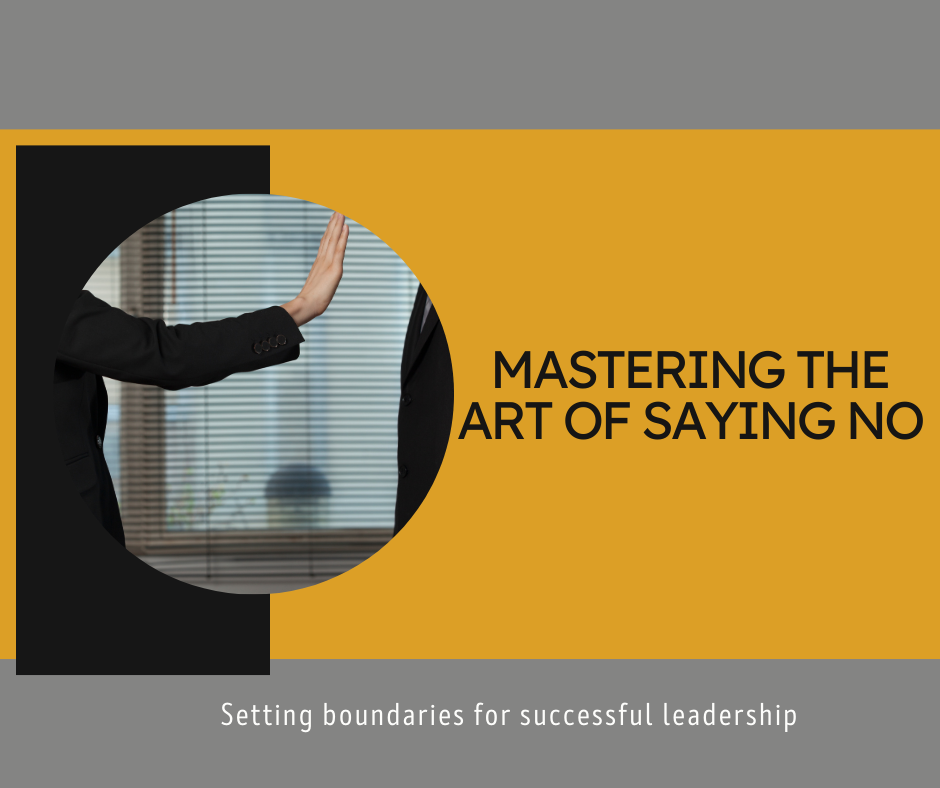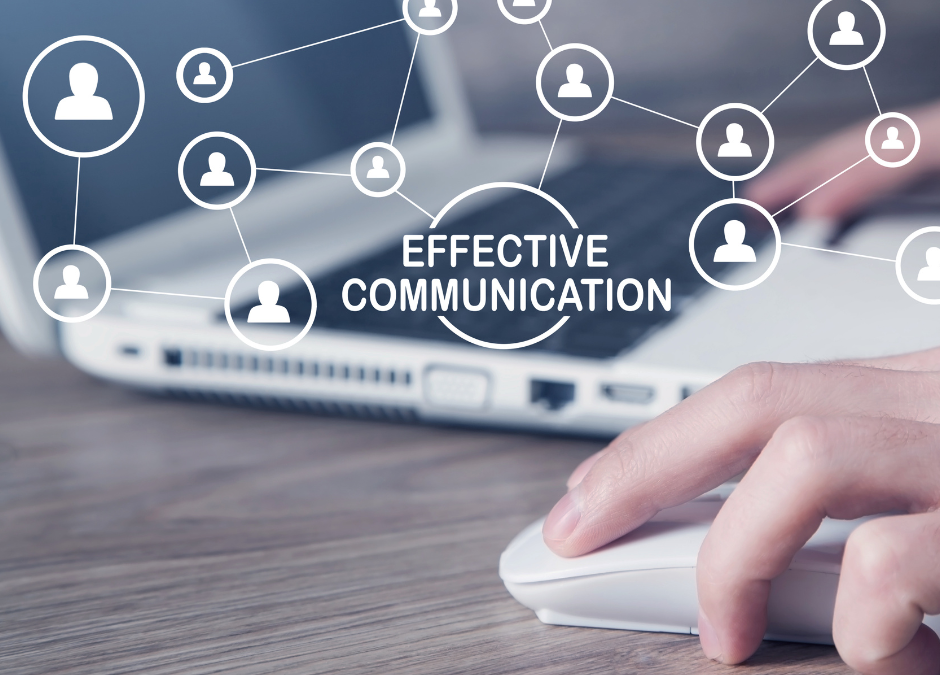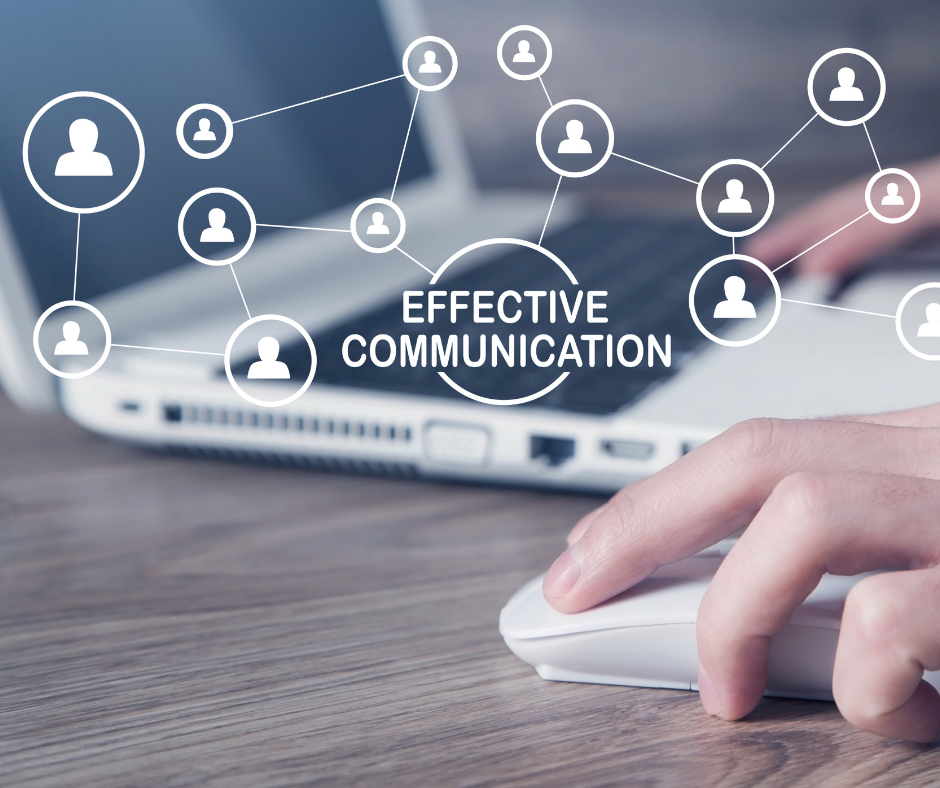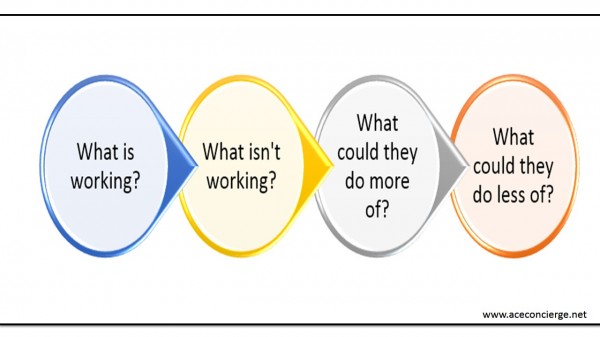
by Ace Concierge | Virtual Assistant | May 8, 2024 | Business Transformation, Communication, Leadership

As a business leader with a hectic schedule, your time is valuable and constantly sought after. Balancing client demands, team projects, and industry obligations can be overwhelming. Failing to establish boundaries and turning down opportunities can result in burnout, reduced efficiency, and a loss of focus on key objectives. Learning to say no is crucial for executives and entrepreneurs looking to regain control of their time and resources. This article will delve into the significance of setting limits, offer tips on politely declining requests, and highlight the advantages of saying no.
The Importance of Setting Boundaries
In today’s always-on, hyper-connected business landscape, it’s easy to feel you need to be available 24/7. The fear of missing out or letting someone down can make turning down opportunities or requests challenging. However, failing to set clear boundaries can severely affect your well-being and your ability to lead effectively.
When you say yes to everything, you spread yourself too thin, leaving little time and energy for the essential tasks and strategic priorities. This can lead to increased stress, diminished focus, and a sense of being overwhelmed and unfulfilled. Ultimately, your productivity, decision-making, and leadership capabilities suffer. According to a survey by the American Psychological Association, 75% of adults reported experiencing moderate to high levels of stress in the past month, with work being a significant contributor. By learning to say no, you can help mitigate the negative impacts of chronic stress and burnout.
Techniques for Politely Declining Requests
Saying no doesn’t have to be aggressive or damaging to your relationships. The right approach can strengthen your professional standing and demonstrate your leadership abilities. Here are some techniques for politely and professionally declining requests:
- Respond Promptly: Don’t leave requests hanging. Acknowledge the request and promptly respond, even if it’s a polite decline. This shows respect for the other person’s time and prevents the situation from dragging on.
- State Your Decision: When declining a request, respond directly and confidently. You do not need to provide a lengthy explanation. A simple statement like “I won’t be able to take this on, but thank you for thinking of me” is sufficient.
- Suggest Alternatives: If appropriate, offer an alternative solution or suggest someone else who may be better suited to the task. This demonstrates that you’re trying to be helpful, even if you can’t directly assist.
- Express Gratitude: Thank the person for the opportunity and let them know you appreciate being considered. This helps maintain a positive relationship, even if you decline the request.
The Benefits of Saying No
Mastering the art of saying no may initially feel uncomfortable, but the benefits far outweigh the short-term discomfort. Here are some of the ways that learning to decline requests can positively impact your business and your life:
- Increased Productivity: You free up time and mental energy to focus on your most critical strategic objectives by saying no to low-priority tasks and commitments. This allows you to be more productive and achieve more significant results.
- Reduced Stress and Burnout: Overcommitting yourself is a surefire path to burnout. According to a study by the World Health Organization, burnout is characterized by feelings of energy depletion, increased mental distance from one’s job, and reduced professional efficacy. Saying no helps you maintain a healthier work-life balance, reduce stress, and avoid the negative impacts of chronic overwhelm.
- Improved Decision-Making: When you’re not stretched thin, you can make better-informed, more thoughtful decisions. This leads to more effective leadership and better outcomes for your business.
By mastering the art of saying no, you can control your time and energy and align your commitments with your highest priorities. This, in turn, can boost your productivity, reduce stress, and make you a more focused, impactful leader.
You have to decide what your highest priorities are and have the courage pleasantly, smilingly, and non-apologetically – to say no to other things. And the way to do that is by having a bigger yes burning inside. Stephen Covey

by Ace Concierge | Virtual Assistant | Feb 28, 2024 | Communication, Email List Building
Are you ready to build a more personal and direct connection with your audience? Cultivating an email list is indispensable for your small business. Let’s talk about it.
List building allows you to share updates, promotions, and valuable content directly to the inboxes of those opt-in recipients. Unlike social media platforms where algorithms can limit the reach of posts, an email list provides a reliable way to engage with customers and potential clients.
Additionally, you can tailor your messages to specific audience segments. This will increase the likelihood of generating leads or driving sales. In a crowded digital space, an email list serves as a valuable tool for building relationships and fostering customer loyalty. That’s so important in today’s platform noise.
This article will explore effective strategies for building and growing an email list, ensuring that small businesses can leverage this powerful marketing tool to its full potential.
Email is the most predictable driver of growth and sales in our business. I prefer email marketing over all other traffic channels. Syed Balkhi – Founder WPBeginner
1. Have a Strong Call to Action (CTA)
- Utilize chatbots and targeted ad campaigns to boost email subscriptions.
- Use pop-up forms and exit-intent popups to capture the attention of website visitors and prompt them to subscribe.
- Communicate the value of subscribing to your email list and prompt visitors to take action.
2. Personalize What You Can
- Address subscribers by name to create a stronger connection and make emails feel more relevant.
- Send targeted content based on factors such as purchase history, engagement level, or demographics to deliver more personalized and valuable content.
3. Use Multiple Social Media Platforms
- Use multiple social media platforms to broaden the reach of your email list growth efforts and attract a wider audience.
- Create and distribute engaging, valuable, and shareable content on social media to spark interest in your brand and offerings, ultimately increasing the likelihood of new email list subscriptions.
4. Offer Incentives
- Provide exclusive discounts to incentivize visitors to join your email list, fostering a sense of urgency and exclusivity.
- Create valuable lead magnets, such as ebooks, whitepapers, templates, or toolkits, to prompt visitors to share their email addresses, addressing specific pain points and being highly relevant to your target audience.
5. Gamify Your Signup Forms
- Integrate interactive elements into your signup forms, such as spin-to-win wheels, quizzes, or challenges, to make the signup process more enjoyable and engaging. By adding an element of fun and interactivity, you can capture your audience’s attention and make the signup process more appealing.
- Differentiate your email list growth efforts from competitors by offering a unique and engaging signup experience through gamification.
By building a strong email list and implementing these effective strategies, you can directly engage your audience and cultivate a loyal subscriber base.
Drop a comment with your suggestions or best practices.

by Ace Concierge | Virtual Assistant | Dec 12, 2019 | Communication, Life Thoughts

The population is constantly tethered to digital technology, romanced by the instant gratification coming from these devices. This has promoted a lack of respect and value for the company you keep.
Fueled by a recent article in Tiny Buddha, “Put Down Your Phone: Why Presence Is the Best Gift You’ll Ever Give”, my brain scanned the images of daily life. You’ll see it everywhere, whether on the street, at home, on a conference call or at a meeting, there’s the distraction of the click, click, click. The head is down, the mind is wandering, and the physically present person or persons have mentally vacated and immersed themselves in a tech device. They’re letting you know that some other matter or person is of much greater worth and significance than anything else around them.
Devices have become the lifeblood of today’s society, putting real-life interactions on the back burner. No longer are people present in the moment, but instead searching for the next best thing, taking a selfie, sending a text, spending money, posting a pic, or otherwise, totally removed from the current situation.
These harmful disconnections are slowly detaching human connections.
I remember reading a story a few years ago about something as simple as standing in line at the grocery store. Standing in line allowed us to think a little bit, and strike up a conversation with the clerk or person behind us. Maybe notice our surroundings. Be touched by some random act of kindness (RAK) or even generate a RAK!
Life before devices meant we weren’t so dopamine-distracted. When did we start needing to numb ourselves? No longer can most people survive without some form of ‘entertainment’ or busy time. It seems that any downtime, away from that virtual distraction, giving folks a moment of ‘reality’, is not within their comfort zones. Is the new norm that it’s freakish not to be scrolling, typing, or responding?
What message does this send? “My device is my priority in life. Not you or the current event.”
Is that what you are trying to convey in meetings, with co-workers, friends, colleagues or loved ones?
In the spirit of connection, here is my challenge: Put down your device and Practice Presence for 30 days using the list below for inspiration.
- If you are at a meeting, BE with your co-workers.
- If you are on a conference call, LISTEN, don’t just hear.
- If you are meeting a friend for lunch, ENJOY their company.
- If you are with your family, INVEST in who they are and those relationships.
- If you are in public, ENGAGE with a clerk, shopkeeper, or ‘stranger’
People feel valued and cared about when you are present. This is the best of what life has to offer.

by Ace Concierge | Virtual Assistant | Oct 22, 2014 | Business Values, Communication, Customer Service

Successful relationships are launched with open and honest communications generating not only trust but a comfortable safety zone for conversation.
You can’t build a foundation with silence or filtered information. It doesn’t work.
Of course, you don’t want to harm feelings or be politically incorrect but if you choose to zip the lips, then you are doing a tremendous disservice to both yourself and the other party.
Misinformation, resentment, or incorrect assumptions may end up taking a leading role because you did not voice your opinion. In valued relationships, whether professional or personal, make sure you ask questions, maintain an open mind, listen, foster feedback, act, don’t react to the responses, and follow up with a summation and action steps of the discussion.
Knowing, tips, tools, and skillset to successfully perform your job is vital to your success but more important is your instinct and soft skills to help nurture your partnership. If your interpersonal communication skills need a little polish or you’re only in it for financial gain, then you may suffer the consequences.
It is so important to uncover what IS working as well as what ISN’T working otherwise the relationship could dissolve.

Confidence in Communications
Thriving vendor – client partnerships prosper with ongoing conversations that don’t merely revolve around sales or projects but also the dynamics of the process as a whole. Initiate the dialog with the desire to listen and communicate clearly. It is a two-way street and you each have something important to say. Encourage a secure, non-judgmental environment.
“Too many business owners and sales people try to sell their product or service, neglecting the fact that their customer is a person. In fact, the customer is a person who has feelings, influences and a mind of their own. They want to be connected with, and to trust and believe the person from which they are buying.” Rebecca Wilson
Honestly, how many times have you thought?
“I wonder when Mr. Park N. Later will send me the files to finish the project?”
“I don’t believe Ms. Jan C. Never followed up on my email last week?”
“Wow! Mr. Bee Frankly is right on top of my feedback survey. This is a great day.”
Do you know what runs through your client’s mind? Are they 100% satisfied with your products AND service?
Recognize there is a vast difference between service and services. Create the ultimate customer experience with unsurpassed service and they will continue to buy your services.
ASK! Don’t assume things are fine simply because you have a contract.
Don’t wait for issues to arise.
Outline your CHIPS™ for Effective 2-Way Communications
CHIPS™: Client Handbook: Ignite Partner Success is your company framework or platform that shapes systems, processes, communications, and strategies for your everyday service and solutions. Let it be a guidepost of how you effectively relate to your stakeholders, creating detailed segments for each facet of your business, like a policy manual.
- Schedule periodic calls to check in to discuss what is working and what isn’t; where can you both improve
- Don’t rely on an email or text message. Things get lost in translation. Making the investment is a values-based opportunity to demonstrate your respect and interest in not just the sale but your client and relationship
- Jot down a few notes highlighting the good, the bad and the ugly
- Give each party plenty of time to speak, vent or otherwise share their thoughts regarding your partnership
- Understand YOUR role is to provide the best customer experience
- Be flexible and willing to compromise
- Understand your client’s point of view
- Clearly and kindly articulate your viewpoints
- Cultivate continuous improvement and dialog
- Summarize the call, reiterating what you heard
- Create action steps
- Ask for feedback about the call
- Before you hang up, commit to the next conversation
Communication leads to community, that is, to understanding, intimacy and mutual valuing. Rollo May
Embrace every relationship you have by investing in authentic conversations because you care enough to want it to succeed.
Because you want to build empowered, valued partnerships.
Because it feels good. It is fulfilling.
Never shy away from asking the real questions, the most difficult questions of what is working and what isn’t working.
Who will you call today?

by Ace Concierge | Virtual Assistant | Apr 29, 2014 | Communication, Content Marketing, Guest Blogger

Let’s Rebel Against Boring
“I fell asleep reading a dull book and dreamed I kept on reading, so I awoke from sheer boredom.”
I’d like to start this post by sharing one of my greatest fears in my role as a video producer and content developer. Are you ready?
To have my content be boring…
You Know…
Dull, uninteresting, flat, humdrum, dull, stale, uninspiring, or just plain…
BLAH!!!!!
I’m hoping that’s not you.
However, the fact is that the web is full of an ample supply of boring crap interrupting our lives on a daily basis.
Plenty of it comes from businesses in the form of advertising or other repetitious marketing humdrum.
I hope you agree that it’s time to write a new script when it comes to business communications. Our customers want more. They expect it.
Therefore…
The single most daunting challenge of every content creator, be it a video producer, web developer, blog author, newsletter designer, social media manager or for that matter any business, is to be memorable, to create a memorable event.
…So memorable in fact that your content actually makes a difference to another person. You help solve a problem, fill a need, or inspire change.
You rock someone’s world!
Joe Pine and Jim Gilmore, authors of the best selling book, The Experience Economy, call memorable events that ENGAGE people in an inherently personal way, EXPERIENCES.
In this article I’ll share some thinking on how to use some principles of experiences and experience design to create more engaging digital communications.
Let’s begin.
Recently I was attracted to a communications effort that was the opposite of boring- one that I would define as engaging and memorable.
Here are some background details.
I began pursuing this new business-learning program a couple of months ago. The media in the program includes 8 podcast (audio recording) and a corresponding transcript.
The business series is about transforming a business into a media company as a component of a new type of marketing strategy. The theme is ‘Media not Marketing.’
How engaging is this new content?
I look forward to new weekly episodes and at times have even been excited when announcements arrived in my Inbox. OK … You might be thinking…Bill needs to get a life. After all, podcast and webinars are a dime a dozen. Snooooze City… Right?
But really… when’s the last time you were looking forward to an e-mail announcing another episode of business content, that seemed to talk directly to you and your needs.
There’s a lesson here. Let’s explore in greater detail.
But first, it might be helpful if I put this experience thing into some context for you.
Another words, why the heck is a video producer writing a blog post connecting experiences to business communication.
My Big Find
My journey into the world of experiences began 10 years ago after re-defining the work I do as a video storyteller, as creating experiences.
My interest in the concept peaked after discovering and reading a book called ‘The Experience Economy-Work is Theatre & Every Business a Stage’, and a trip into the Mountains of Colorado for the annual 3-day gathering (conference) of ‘Experience Economy’ practitioners and evangelist.
The journey has been on going since that first book and conference ten years ago. I’ve practically lived and breathed experiences and business experience design.
My big find is the discovery that EXPERIENCES have become the center of the new business landscape and the critical component needed for business differentiation.
Applying an experience perspective to the development of your digital content can be a game changer for your communications initiatives. It will energize the creation process and help create memorable digital experiences, not more boring and meaningless noise.
Let’s get back to that engaging new program that has me captivated.
Drum roll please…
The name of the program is “New Rainmaker” from Copyblogger Media, LLC.
I’ll apply a few experience design principles to it, that hopefully will help you start re-thinking the process content creation.
Concept One: Language is Important-An Experience vs. Content
The language you use in defining goals and their specific business outcomes can have a dramatic impact on a project’s success. My mind goes to a very different place when I think about designing a compelling experience versus writing a newsletter, producing a video or writing a blog post.
The word experience suggests, for me anyway, something more significant, memorable and worth sharing. It moves the bar in terms of imagining what’s possible.
New Rainmaker is an engaging experience because the program’s producers Brian Clark (The show’s star) and Robert Bruce (co-star) explore new ways, and challenge each other, to be different. In one their ‘behind the scenes’ episodes, they openly discuss a strategy of using storytelling, theatre, and drama to make their show distinct.
Have you ever thought of your work as theatre or drama – your business as a stage?
Concept Two: Great Experiences are Intentionally Designed
Robert and Bruce revealed in their episodes that they devoted 6 months planning the design and release of New Rainmaker. One of their activities during the planning phase included research on current business models and mediums being used by others in the same space. (Competition)
Concept Three: Distinctive Experiences Include Elements from 4 Experiential Realms
The most engaging experiences draw from these four realms.
1. Educational – to learn
2. Entertainiment – to have fun…. to enjoy
3. Escapist – to do…to draw in further… to transport guest emotionally
4. Esthetic- to be… to make your guest want to come in and just hang out…an inviting environment
New Rainmaker emphasizes the educational realm but is more engaging because of the entertainment value that is delivered by the production value designed into the learning experience. Each episode is scripted and background music edited into the production evoking an emotion of suspense to each learning episode. Productions are sprinkled with humor, which helps make the learning more enjoyable.
The overall experience is enhanced as it draws from the Escapist Realm.
Brian Clark accomplishes this through the effective use of storytelling. Most notably, he shares some personal stories that help build trust with his audience.
Often during the 8 episodes, you lose the sense and feeling that you’re listening to a business presentation in front of a computer, to a feeling that you’re in the front row of a theatre. Great storytelling transports people emotionally.
Finally, there is a touch of the Esthetic Realm mixed into New Rainmaker. Clark and Bruce deliver a radio like performance in a conversational and personal manner. Their down to earth style and transparency is inviting and makes you want to hang out and listen awhile longer.
Let me leave you with a final thought and question.
Maybe, business super thinker Tom Peters sums up the importance of business experiences best, in one of his ‘Essentials Book Series called Design.
“We must understand that experience is a very big word, with far reaching implications, but it is nothing short of the basis for a totally re-imagined organizational life form.”
Are your digital communications defined, fresh, immersive, accessible, significant and transformative?
Let’s rebel against boring communications !
Guest Author:
William Gibeault of Story Mavericks
Rock your customers- Grow your business

Connect with Bill
Rock Your Customer Blog
Facebook
Twitter
Youtube
Google +
Pinterest
LinkedIn

by Ace Concierge | Virtual Assistant | Apr 10, 2014 | Communication, Social Media
 The digital landscape is abundant with incredible industry thought leaders sharing the knowledge and best practices in social media. The circle of influencers crest the lists of who to follow and how to engage them.
The digital landscape is abundant with incredible industry thought leaders sharing the knowledge and best practices in social media. The circle of influencers crest the lists of who to follow and how to engage them.
- You admire them.
- You follow them.
- You learn from them.
- You implement their suggestions.
- You share and comment on their posts.
- You believe it is a mutual give and take to build deep relationships and connections.
Social media is BEING social not doing social. Right? It isn’t an automated robotic act of verbal diarrhea to gain and maintain a following. You will surely lose if that is your strategy. You are dealing with real live human beings behind the keystrokes. While we are a push button society, get things done, do it fast; building relationships is a one on one personal endeavor and no amount of sterile replies or automated apps will generate authentic connections.
If your job is content and social media marketing then try to live as a good example of a digital citizen. Christian Vanek
Get real. Be real.
BUT, how does the little guy fair in this vast sea of legendary experts? Is it like swimming with the sharks or do you have the same opportunity to engage in unpretentious dialog?
Are you able to be noticed or shuffled amongst the minnows until you become one of the bigger swimmers?
You will find that many will respond in kind, a quick thank you but there isn’t always an extensive amount of back and forth. Maybe more courtesy replies if you will.
“I firmly believe that respect is a lot more important, and a lot greater, than popularity.” Julius Erving
Your challenge may be to continue prompting the conversations to further deepen your experience and connection with your esteemed colleagues. Have the empowering discussions, becoming more educated and learning from “the best” in the industry. It helps you and your business.
- Be engaging
- Add value
- Ask questions
- Share other people’s content
- Express gratitude
- Be a giver
- Make introductions
- Connect within your community
- Emulate those who inspire you
- Remember to always respond to others
What happens when there is no reply? (Don’t take it personally!)
The Social Disconnect
Does that influence your impression of the individual or impact your level of engagement?
It seems like it would be a dichotomy.
How do these respected professionals write and talk about the essence of social media and relationship marketing, yet they don’t put forth the same? Shouldn’t their actions back up their words? Like Daniel Newman said: Social Media Pundits (Mostly) Suck At Engagement
The problem is the proclamation of engagement as a key part of success in social media. If you think about it when it comes to this group that talks engagement but doesn’t really do it, it starts to just sound like a bunch of kumbayya stuff and not at all like a real strategy. Almost like a “Wag The Dog” strategy for the small circle of elite that want to keep you looking left while they are building their empires on the right.













